
MAG5035
-
Posts
5,884 -
Joined
-
Last visited
Content Type
Profiles
Blogs
Forums
American Weather
Media Demo
Store
Gallery
Posts posted by MAG5035
-
-
8 hours ago, jm1220 said:
Looks like it was quite intense heading down the I-80 corridor. In State College lots of trees down/roads closed. I remember some decent T-storms and small hail when I lived there but this seemed particularly bad. The line bowed out heading that way so I’m sure there was significant wind impact that whole area.
Edit-saw report of 65mph gust at the NWS State College office.
There hasn’t been much major severe to write home about in this part of Central PA for what seems like the last several years but this year has definitely been off to a wild start. Prior to yesterday there was a widespread severe event on 3/16 that really impacted some of the same areas with a few NWS confirmed tornadoes and lots of straight line wind damage in the I-80 corridor as well as the 99 corridor too. That one really hit Bellefonte and surrounding hard.
Last nights line really hit a bit further south.. getting Cambria/Blair/southern Centre/Huntingdon coming in from western PA where it had its largest impacts in and around Pittsburgh. Carrolltown in Cambria County had the most notable damage report, with a cell phone tower being destroyed by the winds. Something you don’t see often outside hurricanes or maybe direct hits from tornadoes. The NWS reportedly surveyed this today and reported that to be straight line wind damage of 110-120mph winds.
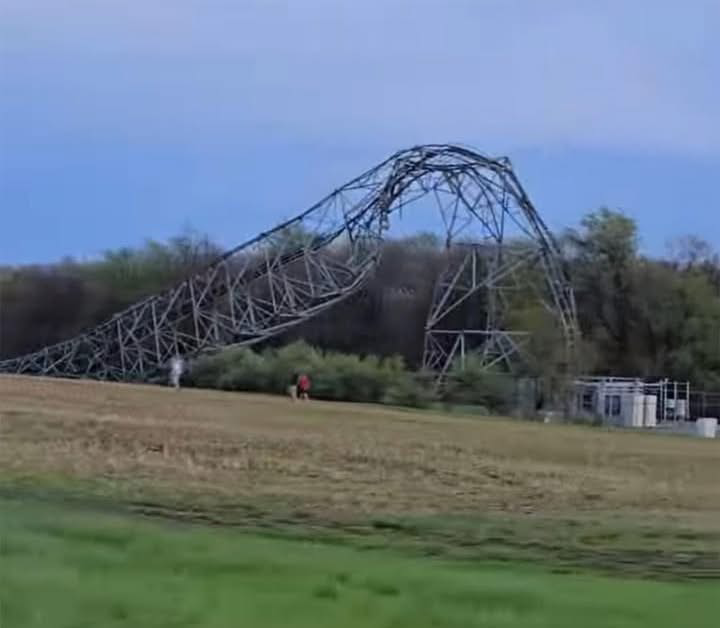
https://www.wtaj.com/weather/nws-survey-confirms-straight-line-wind-damage-in-cambria-county/
There was other widespread issues around here and tens of thousands of folks without power. I was out here for a couple hours and my parents up the road didn’t get theirs back until earlier today. No damage here at home fortunately.
-
 2
2
-
 1
1
-
-
-
Pretty active pattern setting up this week in terms of multiple opportunities for rainfall, so hopefully can start chipping away at the established drought conditions in the SE part of the state.
Despite that, the focus of the heaviest QPF is squared in the Ohio and Mid Mississippi Valley. Significant flooding appears a pretty good possibility there. Those are some pretty prolific QPF numbers in the bullseye, even over a 7 day period.
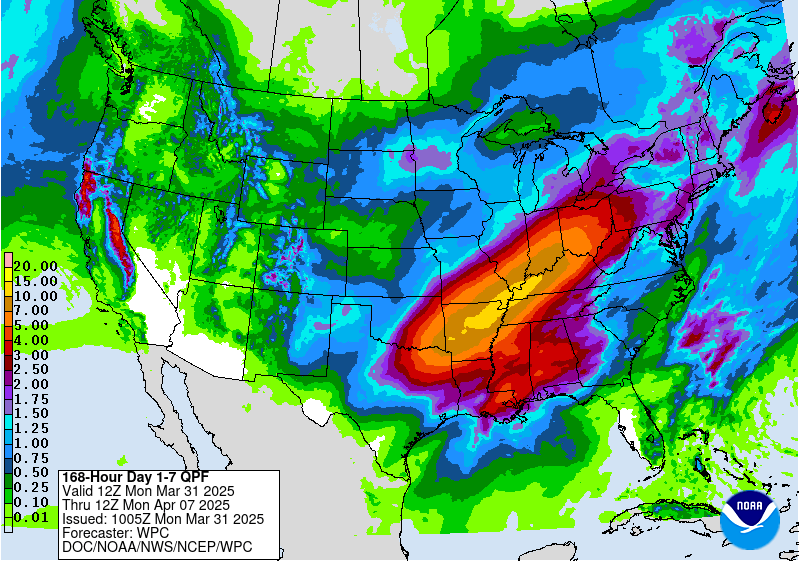
-
 5
5
-
-
8 hours ago, WmsptWx said:
I also think politics becoming involved at the same time of the "Day In The Life" post came about caused a lot of strife and I blame one individual who is also no longer posting for that. I know that individual is dealing with a battle of their own and I wish them the best and hope they beat it, but as far as posting on a weather forum, good riddance.
As for me? My personal life went directly to shit about three weeks ago. As a result I am currently in Ridge and Valley Huntingdon county. This place hasn't been too appealing knowing that the posting here is wet dreams for non-existent winter weather, and people still trying to figure out Bubbler's beef. I still read but if things don't improve in here in short order, I don't even know if I'll do that.
Something needs to be resolved and I don't think Mike leaving is the fix.
If I’m being honest the politics getting into the discussion was about the only thing in here that really made me feel any kind of way as far as getting heated. Not because it was brought up or necessarily from the differences in opinion but simply because the topic was beyond having a reasonable discussion, which obviously is a thing that goes way beyond the small confines of our subforum. I’ll refrain from rehashing further on that.
Otherwise I feel the “discourse” in here is fairly tame compared to some of the stuff that occasionally flares up in the bigger subforums IMO. It’s obviously anyone’s choice whether they want or need to step aside and take a break and such, but I certainly don’t feel it’s necessary for anyone in here to do so from anything that’s been said recently.
Hope everything works out for you.
-
 3
3
-
-
KUNV had a peak gust of 64 mph, KJST 63mph.
-
 1
1
-
-
Power has now gone out after the fact.
At least a couple trees came down in the woods around my parents house up the road in Bellwood.
-
 2
2
-
-
The wind part was quick but it was legit. Power flashed off at the height of the winds so unsure of the gusts, but definitely was easily of the severe variety. Had some pea sized hail as well.
-
Looking at mesoanalysis, dynamics are definitely the big factor in the severe threat from this line. Effective helicity is pretty notable in a narrow corridor of west central PA just ahead of the line.
Same goes for effective bulk shear as well. Limiting factor is CAPE, which is only of the few hundred J/kg variety in western PA. Thus, QLCS spinups are quite possible directly associated with the line given significant helicity/shear. Eastern PA still pretty stable, so we shall see how the atmosphere evolves as the line traverses PA.
We’re def in the warm sector here. Quite warm/humid considering the date (66/58ºF on the station here). Winds are really ripping. KAOO wind is SSE 33mph gust to 45 with a high gust of 55mph.
-
 1
1
-
-
Multiple tornado warnings with the portion of the line in western PA roughly from Ligonier to Indiana
-
 1
1
-
-
4 hours ago, WmsptWx said:
This is just simply not true. Bubbler and the Trainer post every day, multiple times a day, four seasons of the year and I haven't seen Bubbler post in about two weeks and the Trainer came on just to address somebody's asshurt over a fun post.
I think your presence also may have something to do with it.
If you use mobile you might not see it but there’s a sidebar that shows stuff like most popular posts and days as well as the top 4 posters in the topic. Bubbler and ITT are #1 and #3. Blizz and mitchnick are the other two. Mitch has been posting in the Mid-Atl threads and there hasn’t been much snow digital or otherwise for blizz to share. Definitely a dynamic changer for sure. Those 4 combined account for like 44% of the posts in this thread haha.
Also, despite the general winter is dead theme today..it’s probably not going to be dead for you tonight. I expect at least some of that precipitation in northern Ohio and western PA to make it over as far as you and it’ll likely be mostly snow. Nothing serious but could be a quick coating. Not much is progged to make it past the I-99 corridor in the rest of C-PA otherwise.
-
0.61” here with this morning’s round of rain.
Best dynamics in terms of shear/helicity/high winds aloft reside with the main area of heavy rain (with imbedded line) traversing Eastern PA currently. I think severe potential is there but limited with secondary development of storms late this afternoon in the dry slot. Western PA has built up surface CAPE of several hundred J/kg back in the dry slot per mesoanalysis and some decent LI and low level lapse rates which has led to some storm development. I think the main threat is mainly sub severe gusty winds/hail with the potential for some more organized storms strong enough to warrant a few warnings as winds aloft aren’t quite as strong there. Tornado threat not zero but very unlikely IMO. Best helicity as mentioned is associated with the main stuff moving through eastern PA.
Modeled CAPE on high res guidance going into this evening is best in western PA decreasing to not very much once to the Sus Valley. Thus I think main threat is a round or two of gusty showers/storms with maybe a warned storm or two.
-
 1
1
-
-
Made it up to 60ºF here.
-
Well, the 18z GFS just did it again.
-
 1
1
-
-
The only period I’m semi-interested in for anything wintry for the time being is that wave being progged in about the 3/7-8 timeframe, which comes on the heels of what likely will be a fairly potent GL cutter that will hopefully deliver some kind of decent rainfall in the eastern half of the state. Not expecting a phasing scenario so will have to see how the wave tracks across. 18z GFS tracking similar to the 12z Euro with the GFS a bit colder. One issue I’m already seeing progged is low level and surface temps could be an issue in the lower elevations like the Sus Valley if the wave delivers any kind of respectable precip to C-PA. After that we look to moderate significantly going into mid-month as despite the NAO forecast to go negative we counter with a pretty positive EPO and negative PNA. Major strat warming over the pole and a displacement/stretching of the stratospheric PV could eventually have implications down the road for late month, but of course you need more to go right storm wise and bigger - temp anomalies with respect to normal to remain in the snow game when you get to that late in the season.
Climo wise CTP mentioned in their AFD today that MDT finished met winter (DJF) at 31.1ºF for average temp, which was 2.2ºF below normal. Good for the coldest winter since 2014-2015. Too bad that came with only 15.6” of snowfall, which is about 66% of average to date. Worse yet in the snow dept is Philly, only at 8.1” (42% of normal). Places like the deep Louisiana bayou country, New Orleans, Pensacola, etc have technically had snowier winters with that historic storm they got. Also underscores how dry that part of the state has been this winter as well as Philly is at 2.98” total precip YTD out of an average 5.99”. Driest was 1992 with 2.19”.
-
 3
3
-
-
4 hours ago, CASH_COOP said:
I came from his blog as well. Sorry @Blizzard92
I do believe he was referenced at the tail end of the CNN article about the terminations.
2 hours ago, paweather said:This is a weather thread and only weather. People have their own opinions.
They do. I give my opinions in here too, mostly on the weather. I don’t find it necessarily off topic or “non weather related” to discuss the impact of terminating hundreds of very intelligent people in an agency that maintains/improves/provides weather forecasts and life saving warnings to all US and maritime interests, free and open access to computer modelling, analysis and data that all private weather entities (including free model sites) and weather enthusiasts like yourself use. All for an annual cost to the taxpayer that amounts to less than two months subscription to DT’s newsletter. But that’s just my opinion I suppose.
-
 5
5
-
-
-
1 hour ago, WmsptWx said:
This CWA has been a bit splintered this season. Up here the first half of winter was pretty snowy. We never had an event over I think 6 inches give or take, and most were of the 2-3 inch variety, but it's been cold from late November until the current time with only a few warm days.
I don't think we have had a 60 degree day since before Thanksgiving. I may be wrong about that. I think we've had only a few 50 degree days and not many more 40 degree days.
I know that hasn't been the case in the SE portion of this CWA, but this has certainly been a long, hard winter up here.
I am hoping we are rewarded with a long, pleasant (warm enough to keep the water comfortable but not too hot to melt balls away in minutes) spring and summer with some outbreaks.
It has, the LSV has generally had a much better winter than last winter.. but still running a few to several inches below normal to date (closer to normal along the M/D line). The Laurel’s region has had a much better snow season with respect to normal than probably the last several winters given long periods of favorable flow for upslope and lake effect. Climo stations like Laurel Summit and Somerset are running solidly above average to date. The actual central part of the state off the mountains has been lacking in the snow department the most, due to a lack of synoptic snows. State College is behind about 10 inches for the winter to date.
Out of 16 measurable snowfalls I’ve recorded this winter so far to get to only 23.9”, the Jan 19-20 snow event was the only one that got past 3 inches here… and it took the post storm upslope/LES to get to that 4.1”. I still have about 6 inches just to get to last year’s lackluster snow total. The rough average in this part of town against the ridgeline is roughly in the 45-50” range. Despite that, aside from about a day or so in between sleet events the first week of Feb during pinger week 2025 (I cracked 60ºF here that week), I’ve had some kind of snow on the ground every day since New Years. The 3-4” of it on the ground right now is just about bulletproof.
The lack of a signature storm in our area has obviously been the biggest knock on what has otherwise been probably the coldest winter temp wise overall since 14-15. Can that change in March? Certainly.. next month isn’t looking overly warm in the longer range stuff for the northeast right now. I think we’ll continue to have a pattern that will at times present the opportunity, but we’ll have to see if things can actually line up for a change. I had been eyeing that Feb 28-Mar 1 period that had amplification and a big storm in some runs a couple days ago.. but that has largely disappeared.
-
 3
3
-
-
-
Still quite windy here, and the temp has fallen back all the way to 15ºF already.. so definitely not pleasant out. My station had a peak wind of 51 mph early today. No real major direct issues from the wind around here fortunately, other than the combo with the snow bands and blowing and drifting last night. A lot of the secondary back roads around here were tough to drive on last night and early this morning.
-
 2
2
-
-
In the middle of a heavy snowband currently. I’m not sure how much snow has fallen from these bands tonight but the amount of blowing and drifting on the roads around here has made this the most impactful event of the season IMO. This has easily been an advisory caliber event with near blizzard conditions at times.
-
 2
2
-
-
Around here both KAOO and KJST have had 58mph peak wind gusts so far to go along with the 59.5mph peak gust I got here at home earlier.
-
 2
2
-
-
1 hour ago, psuhoffman said:
I didn't see a lot of KU examples with this H5 progression...what seemed more common was messy multiple wave or disjointed storms like you just described. The quote of mine above was in a back and forth with @Ji and not to be taken literally lol. But I was and am arguing for the possibility this should be further north. March 2017 was somewhat similar to this in terms of the H5 track but would have been way more amplified for the reasons you stated.
But what I didn't find were any examples of a h5 setup like this with a closed ULL back over the upper midwest tracking through PA that resulted in a big snowstorm 8"+ for Richmond or the Delmarva like guidance has been showing. I couldn't find a single example. I found a lot of messier storms further north and a few examples of a NC snowstorm from a SS wave that had no interaction with the NS but in those cases it ended up SOUTH of where guidance is now...I saw nothing that looked like this. But I guess there can always be a first.
But I do feel like if this remains as amplified as it is now, it makes more sense for the wave in the TN valley to be more amplified and the gulf wave less given the upper levels. This would translate to a further north but not as amplified system into the mid atlantic IMO.
The other option would be for this to keep trending south and match the analogs I found with a true southeast snowstorm under a displaced TPV sitting over the upper midwest. Feb 1980 fits that but it was mostly NC up to VA beach with not a lot of snow north of there.
I guess the strength of the cold air mass pressing with that displaced TPV isn’t something to be overlooked either with a large area of more than -30ºF below average in a big portion of the Central US and Lower Ohio Valley. That probably could be an argument the other way that the boundary that southern stream wave runs on ends up being further south in a more progressive/unphased scenario. Really wish we could’ve been able to build the big western ridge to amp this setup.
I still think the 500mb vort passage itself is going to generate a lighter snow event on it’s own, as there is likely to be some interaction.. even if it’s too late to draw in the coastal low. That does seem to have pretty solid model support across the board.. even with the more progressive and southeast solutions. That’s something where the finer details won’t be modeled well until it’s solidly into the range of the meso stuff.
-
 3
3
-
 1
1
-
-
It’s pretty wild outside right now. Most of the roads around here have snow on them from the snow falling and/or blowing around and they all flash froze underneath that. Certainly seems like the biggest wind event of the winter in the early going.
-
 2
2
-
-
And I had a gust on the weather station to 59.5mph while I was writing all that.
-
 1
1
-

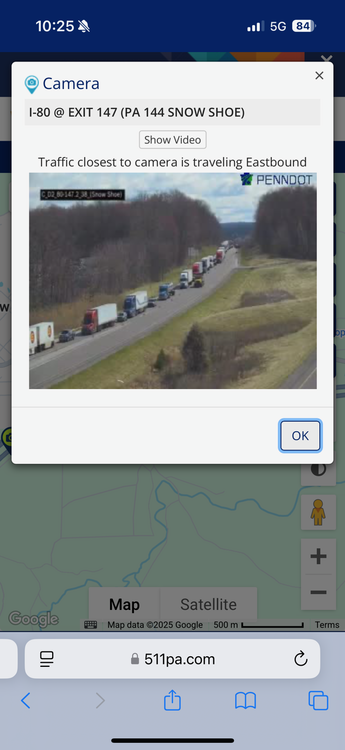
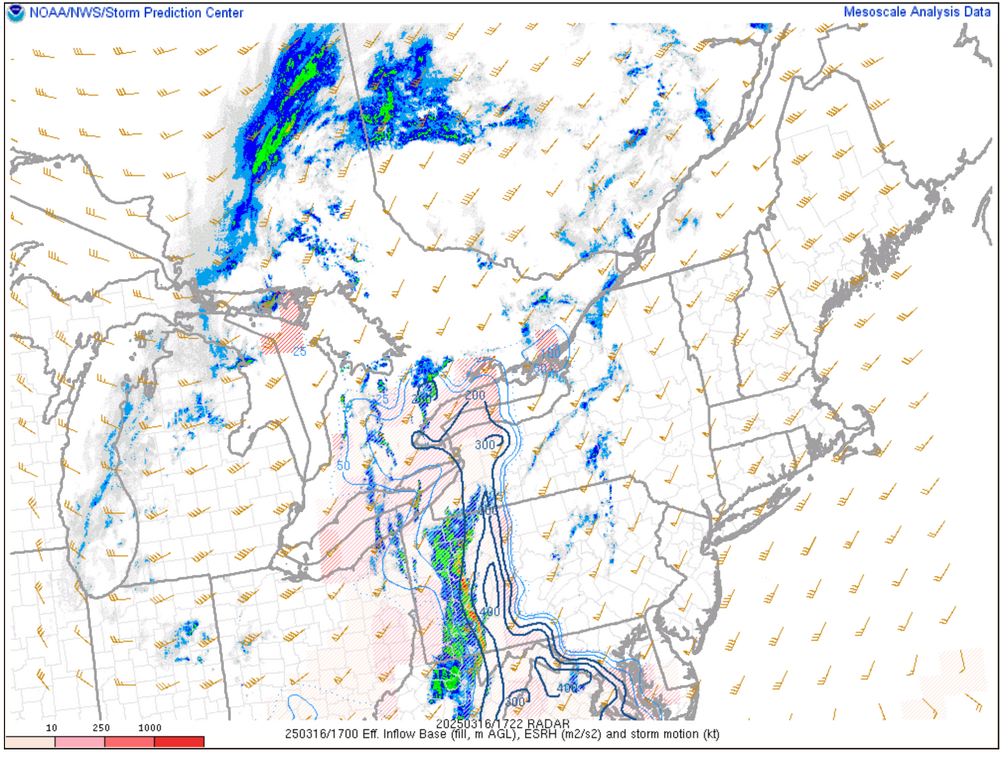

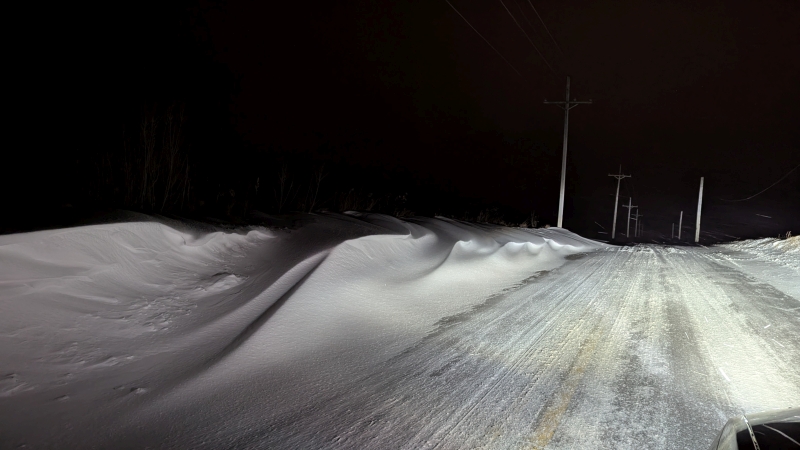
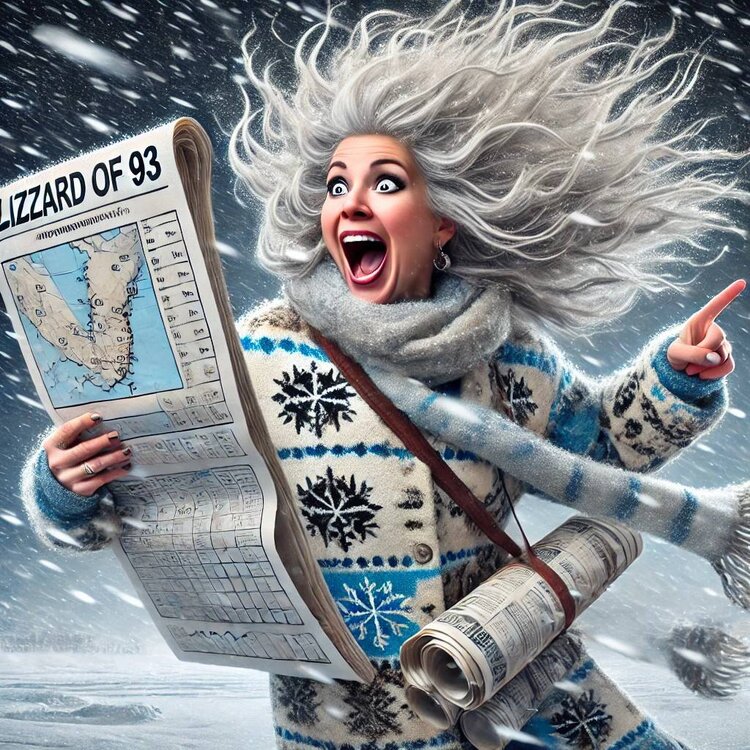

Central PA Spring 2025
in Upstate New York/Pennsylvania
Posted
Stayed in it and finished the full mow of my house and the neighbors with this bearing down.
Worst of this missed here to the west as this is riding up through Cambria and Clearfield with yet another tornado warning in Clearfield. Likely to cause more issues there I’m sure for the many folks in and around there that still don’t have power from Tuesday.